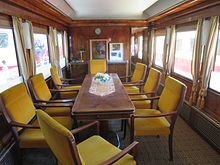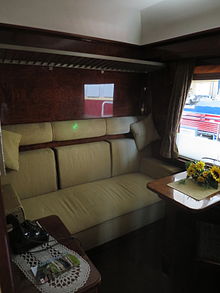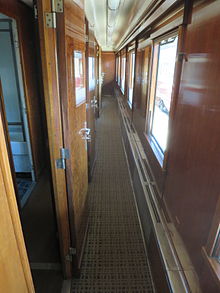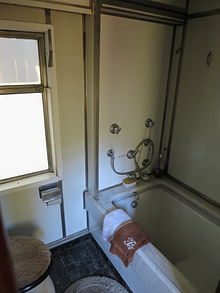DR saloon car 10208
| Salon car 10 208 Bln | |
|---|---|
|
Salon car 10 208 Bln in the DB Museum Koblenz
|
|
| Numbering: | 10208 Bln (1938), 10308 Ffm |
| Number: | 1 |
| Manufacturer: | Left-Hofmann |
| Year of construction (s): | 1938 |
| Axis formula : | 2 × Görlitz type bogies |
| Genre : | Salon 4ü-38 |
| Gauge : | 1435 mm ( standard gauge ) |
| Length over buffers: | 23,500 mm |
| Service mass: | 59 t |
| Top speed: | 200 km / h |
| Seats: | five compartments, one saloon |
The saloon car 10208 of the Deutsche Reichsbahn was built in 1938 for the Reich Minister of Transport and General Director of the Deutsche Reichsbahn , Julius Dorpmüller . It is preserved as a museum in the DB Museum Koblenz .
description
The saloon car 10208 is a skirted car , based on the style of the most modern express train carriages of the Deutsche Reichsbahn for international traffic at the end of the 1930s .
The entrance area at one end of the car was designed as a small salon, followed by the large salon in the length of three window axes. A conference table with seven movable armchairs, a writing desk and a music cabinet were installed here. Both rooms took up the entire width of the car. This was followed by a corridor with side-by-side compartments : First - mirrored in their floor plan - two “apartments”, each consisting of a living / sleeping area with an adjoining toilet / washroom. Between these two wet cells there was a hip bathtub that could be made equally accessible or closed with sliding walls from both sides. In front of the wet rooms there was an inner connecting corridor between the two living / sleeping compartments, in addition to the side corridor that reached from the salon to the entry area at the other end of the car. Two further sleeping compartments were connected to the two apartments, with the same technical equipment as the sleeping car of the time . The partition between these two compartments could be folded away. This was followed by another, somewhat larger sleeping compartment for an accompanying conductor , which also contained a kitchenette. A toilet, accessible from the final, second entrance area, completed the spatial program.
history
Reichsbahn time
Linke-Hofmann delivered the saloon car under the serial number 6045.1. It cost 371,760 RM , was reserved for personal use by the General Director of the Deutsche Reichsbahn and for this purpose was located in Berlin Anhalter Bahnhof . Dorpmüller was bothered by the high noise level while driving, so that the sound insulation had to be improved in early 1939. The too weak heating had to be strengthened in 1942. As a rule, at the end of the train , the vehicle ran with the saloon to the rear, so that the route backwards could be clearly observed from the saloon.
At the end of the war, the car was in the Munich-Pasing train station , where it was looted and then damaged. In 1947 it was refurbished, with the space occupied by the wet cell and the bathtub being added to the first compartment. This made it so spacious that it could now also accommodate a desk and armchair. The other compartments have also been modernized and redesigned. A larger kitchen was also installed in the companion compartment. The car was now stationed in Hanover and was available to the director of the railway in the British zone of occupation . In 1949 it became the official vehicle of the President of the Reichsbahndirektion Frankfurt and was now based in the Frankfurt (Main) Süd train station .
German Federal Railroad
He kept the designation "company car", while all other such vehicles since July 5, 1951 by the German Federal Railroad were again referred to as "saloon cars". The 10208 car was now used frequently. In 1950 alone, it was in use for 169 days and was attached to 275 trains, which required 553 shunting movements , which took place at 52 stations . In 1951, this gave rise to the idea of equipping the car with its own electric motor so that it could maneuver on its own, a conversion that was estimated at 10,000 DM . The project was then not pursued any further. In the next few years, however, the car was redesigned several times: in 1953/54 the furniture was slightly changed. After it was parked from 1955 to 1958, it was fundamentally rebuilt again in 1958 and the floor plan approximated that of 1938. The entry area in front of the salon was now without any further use and the partition between them was moved towards the end of the car in order to gain space in the salon. The salon was given a long conference table with seven seats. The main compartment was made smaller again and the sequence of compartment - wet cell - hip bathtub - wet cell (all three connected with an inner side corridor) - compartment was restored. In 1962 the original bellows were exchanged for the rubber bulges. In 1965, the saloon car was the third car in the special train of Queen Elizabeth II on her state visit to the Federal Republic of Germany . It was intended here for the Duke of Edinburgh and was specially renovated for it. The salon in particular has been refurbished.
In 1967 and 1969 renovations were carried out again: the interior of the salon was taken back to the state it was before the royal service in 1965. Again a long conference table and this time eight seats were built into the salon. In 1970, the vehicle was still used in a historic setting: It was on the special train for Federal Chancellor Willy Brandt , with which he drove to the Erfurt summit meeting with Willi Stoph on March 21, 1970 .
From the end of 1970 the car was upgraded for a speed of 160 km / h. For this, the old were bogies of type Görlitz by such the type Minden-Deutz replaced. In 1974 the traditional green paintwork was replaced by the colors of the Trans Europ Express and Intercity transport , red / beige. In 1978 the car was upgraded to 200 km / h. From around 1980 it could also be rented by private interested parties. This was done for the price of 20 first- class tickets plus a provision fee. The car ran in special election campaign trains run by Willy Brandt and Helmut Schmidt . 1992–1994 it was turned off until asbestos removal was carried out. For recordings for the film " Duel - Enemy at the Gates ", the exterior of the car was restored to its original condition in 2000.
Numbers
The vehicle was renamed numerous times:
| number | annotation |
|---|---|
| 10 208 Bln | 1938-1945 |
| 10 208 Han | 1947-1949 |
| 10 208 Fra | 1949-1966 |
| 10 308 | 1966 |
| 51 80 89-40 308-4, su | 1967-1971 |
| 51 80 89-80 308-5, [WG] Sugt | 1971-1978 |
| 51 80 89-90 308-3 WGSügen | 1978-1986 |
| 51 80 89-90 308-3 WGSüg | 1986-2000 |
| 10 208 Bln | since 2000 |
Museum object
In the appearance, which was brought back for filming in 2000 and approximated to the original condition - green paint, designation: 10 208 Bln - the "Dorpmüller-Wagen" has since been in one of the exhibition halls of the DB Museum Koblenz and can be viewed there.
swell
- Walter Haberling: Reichsbahn saloon car. Types and uses during the Reichsbahn and Bundesbahn times . Freiburg 2010. ISBN 978-3-88255-679-7 , pp. 108-117.
- Description on the object in the DB Museum Koblenz.




